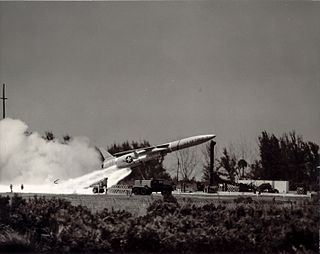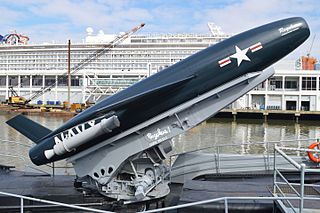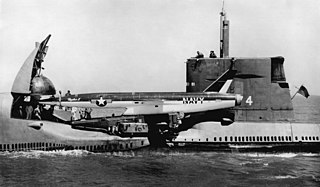 W
WThe North American Aviation AGM-28 Hound Dog was a supersonic, turbojet-propelled, air-launched cruise missile developed in 1959 for the United States Air Force. It was primarily designed to be capable of attacking Soviet ground-based air defense sites prior to a potential air attack by B-52 Stratofortress long range bombers during the Cold War. The Hound Dog was first given the designation B-77, then redesignated GAM-77, and finally as AGM-28. It was conceived as a temporary standoff missile for the B-52, to be used until the GAM-87 Skybolt air-launched ballistic missile was available. Instead, the Skybolt was cancelled within a few years and the Hound Dog continued to be deployed for a total of 15 years until its replacement by newer missiles, including the AGM-69 SRAM and then the AGM-86 ALCM.
 W
WThe AGM-86 ALCM is an American subsonic air-launched cruise missile (ALCM) built by Boeing and operated by the United States Air Force. This missile was developed to increase the effectiveness and survivability of the Boeing B-52H Stratofortress strategic bomber. The missile dilutes an enemy's forces and complicates air defense of its territory.
 W
WThe AGM-129 ACM was a low-observable, subsonic, turbofan-powered, air-launched cruise missile originally designed and built by General Dynamics and eventually acquired by Raytheon Missile Systems. Prior to its withdrawal from service in 2012, the AGM-129A was carried exclusively by the US Air Force's B-52H Stratofortress bombers.
 W
WThe Ground Launched Cruise Missile, or GLCM, was a ground-launched cruise missile developed by the United States Air Force in the last decade of the Cold War and disarmed under the INF Treaty.
 W
WThe GAM-63 RASCAL was a supersonic air-to-surface missile that was developed by the Bell Aircraft Company. The RASCAL was the United States Air Force's first nuclear armed standoff missile. The RASCAL was initially designated the ASM-A-2, then re-designated the B-63 in 1951 and finally re-designated the GAM-63 in 1955. The name RASCAL was the acronym for RAdar SCAnning Link, the missile's guidance system. The RASCAL project was cancelled in September 1958.
 W
WThe Martin MGM-1 Matador was the first operational surface-to-surface cruise missile designed and built by the United States. It was developed after World War II, drawing upon their wartime experience with creating the Republic-Ford JB-2, a copy of the German V-1. The Matador was similar in concept to the V-1, but it included a radio command that allowed in-flight course corrections. This allowed accuracy to be maintained over greatly extended ranges of just under 1000 km. To allow these ranges, the Matador was powered by a small turbojet engine in place of the V-1's much less efficient pulsejet.
 W
WThe Martin Mace was a tactical cruise missile developed from the Martin TM-61 Matador later MGM-1 Matador. It was replaced by the MGM-31 Pershing missile by then Secretary of Defence Robert McNamara, and later in its role as a cruise missile for West Germany, by the BGM-109G Ground Launched Cruise Missile.
 W
WThe Northrop SM-62 Snark was an early-model intercontinental range ground-launched cruise missile that could carry a W39 thermonuclear warhead. The Snark was deployed by the United States Air Force's Strategic Air Command from 1958 through 1961. It represented an important step in weapons technology during the Cold War. The Snark took its name from the author Lewis Carroll's character the "snark".
 W
WThe North American SM-64 Navaho was a supersonic intercontinental cruise missile project built by North American Aviation (NAA). The final design was capable of delivering a nuclear weapon to the USSR from bases in the US, while cruising at Mach 3 at 60,000 feet (18,000 m) altitude. The missile is named after the Navajo Nation.
 W
WThe XSSM-A-5 Boojum, also known by the project number MX-775B, was a supersonic cruise missile developed by the Northrop Corporation for the United States Air Force in the late 1940s. Intended to deliver a nuclear warhead over intercontinental range, it was determined to be too ambitious a project given technical difficulties with the SM-62 Snark which it was to follow on from, and was canceled in 1951.
 W
WThe SSM-N-8A Regulus or the Regulus I was a United States Navy-developed ship-and-submarine-launched, nuclear-capable turbojet-powered second generation cruise missile, deployed from 1955 to 1964. Its development was an outgrowth of U.S. Navy tests conducted with the German V-1 missile at Naval Air Station Point Mugu in California. Its barrel-shaped fuselage resembled that of numerous fighter aircraft designs of the era, but without a cockpit. Test articles of the Regulus were equipped with landing gear and could take off and land like an airplane. When the missiles were deployed they were launched from a rail launcher, and equipped with a pair of Aerojet JATO bottles on the aft end of the fuselage.
 W
WThe SSM-N-8A Regulus or the Regulus I was a United States Navy-developed ship-and-submarine-launched, nuclear-capable turbojet-powered second generation cruise missile, deployed from 1955 to 1964. Its development was an outgrowth of U.S. Navy tests conducted with the German V-1 missile at Naval Air Station Point Mugu in California. Its barrel-shaped fuselage resembled that of numerous fighter aircraft designs of the era, but without a cockpit. Test articles of the Regulus were equipped with landing gear and could take off and land like an airplane. When the missiles were deployed they were launched from a rail launcher, and equipped with a pair of Aerojet JATO bottles on the aft end of the fuselage.
 W
WThe SSM-N-9 Regulus II cruise missile is a supersonic guided missile armed with a nuclear warhead, intended for launching from surface ships and submarines of the U.S. Navy (USN).
 W
WThe Supersonic Low Altitude Missile or SLAM was a U.S. Air Force nuclear weapons project conceived around 1955, and cancelled in 1964. SLAMs were conceived of as unmanned nuclear-powered ramjets capable of delivering thermonuclear warheads deep into enemy territory. The development of ICBMs in the 1950s rendered the concept of SLAMs obsolete. Advances in defensive ground radar also made the stratagem of low-altitude evasion ineffective. Although it never proceeded beyond the initial design and testing phase before being declared obsolete, the design contained several radical innovations as a nuclear delivery system.
 W
WThe Tomahawk Land Attack Missile (TLAM) is a long-range, all-weather, jet-powered, subsonic cruise missile that is primarily used by the United States Navy and Royal Navy in ship- and submarine-based land-attack operations.